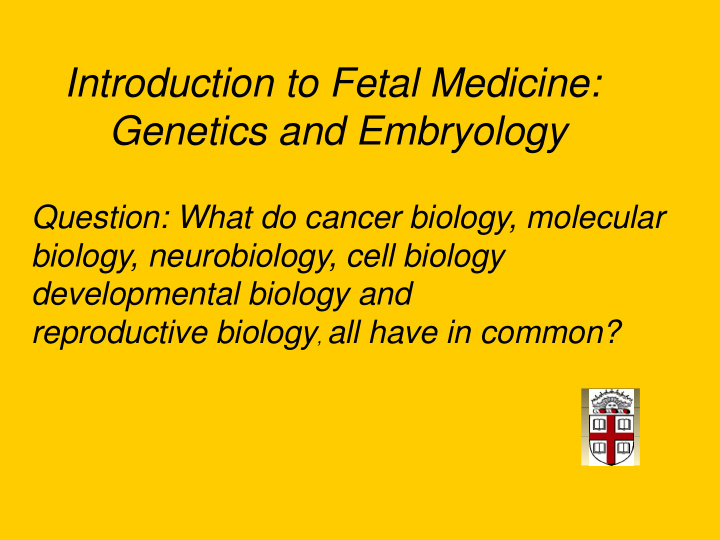



Introduction to Fetal Medicine: Genetics and Embryology Question: What do cancer biology, molecular biology, neurobiology, cell biology developmental biology and reproductive biology , all have in common?
Answer : BIOLOGY !
CENTRAL DOGMA DNA → RNA → Protein Information Flow 1950 - 1960's Protein → function(s) Information Flow 1970 - 1990's DNA → RNA → Protein → function(s) Information Flow 1990's – 2000’s Expression arrays, Chips, Proteomics Engineering, Automation/Robotics, Bioinformatics
“Genome News” Surprises from the genome So few genes! Similarity in genome size between simple and complex organisms “Extraneous” Sequence vs “Junk DNA” Source and form of human Variation, SNPs & CNVs
B. Genetic controls of development Conceptual framework • Programming • Critical windows • Spatio-temporal specificity
Programming Oogenesis Fertilization Implantation Placentation Organogenesis Hyperplastic Growth Hypertrophic Growth Functional Maturation Preparation for Postnatal Life
B. Genetic controls of development Conceptual framework • Programming • Critical windows • Spatio-temporal specificity
Critical Windows During Development =/ Adapted from: Jaenisch. Trends Genetics 1997
B. Genetic controls on development Conceptual framework • Programming • Critical windows • Spatio-temporal specificity
C. Developmental regulators • Specification factors: T-Box genes and congenital heart disease • Transcription factors: Foxd1 and renal anomalies; Pax3 and DiGeorge syndrome • Transmembrane signaling: ET receptors and Hirsprung’s disease; Jagged 1/Notch1 in Alagile’s syndrome and biliary atresia • Organizers: Nodal, Lefty and heart disease
The Hox Gene Cluster
Schematic of Cardiac Morphogenesis in Humans Migration of Generation of single Looping and Mature precardial cells cardiac tube formation of cushions heart From D. Srivastava and E. Olson, Nature 2000
D. Example: cardiac organogenesis • Early specification: “tinman”, Nkx2.5 • Midline fusion GATA 4 • Cardiomyocyte transformation/prolif eration MEF2, GATA4, p57 kip2 • Looping morphogenesis SMAD2 • Segmentation and growth of cardiac chambers TBX5, RXR α • Valvulogenesis d,eHAND, Nkx2.5 • Outflow tract septation and patterning of great vessels TBX2
D. Example: gut organogenesis • Early specification: “tinman”, Nkx2.5 • Midline fusion GATA 4 • Cardiomyocyte transformation/prolif eration MEF2, GATA4, p57 kip2 • Looping morphogenesis SMAD2 • Segmentation and growth of cardiac chambers TBX5, RXR α • Valvulogenesis d,eHAND, Nkx2.5 • Outflow tract septation and patterning of great vessels TBX2
If it is genetic, why doesn’t it look genetic? Array-based SNP and CNV analysis
E. Patterns of inheritance 1.Autosomal dominant disorders 2.Autosomal recessive disorders 3.X-linked disorders 4.Chromosomal disorders Deletion syndromes Aneuploidy Uniparental disomy 5.Mitochondrial disorders 6.Polygenetic/multifactorial disorders 7.Gene-environment interactions Nutrition, oxygen, toxins
Osteogenesis Imperfecta Type I autosomal dominant age at presentation: 2-6 years Type II (congenital lethal OI) autosomal recessive pre or perinatal death (pulmonary hypoplasia) Type III (severe prograssive OI) autosomal dominant marked progressive limb and spine deformity Type IV autosomal dominant most mild form •demineralization, cortical thinning •multiple fractures with pseudoarthrosis •exuberant callus formation •blue sclerae •presenile deafness •dentinogenisis imperfecta •wide sutures + Wormian bones
E. Patterns of inheritance 1.Autosomal dominant disorders 2.Autosomal recessive disorders 3.X-linked disorders 4.Chromosomal disorders Deletion syndromes Aneuploidy Uniparental disomy 5.Mitochondrial disorders 6.Polygenetic/multifactorial disorders 7.Gene-environment interactions: Nutrition, oxygen, toxins
Name 3! Cystic Fibrosis Sickle Cell Disease Gaucher’s
Which present in fetal life? Cystic fibrosis (meconium ileus) Gaucher’s (hydrops fetalis)
E. Patterns of inheritance 1. Autosomal dominant disorders 2. Autosomal recessive disorders 3. X-linked disorders 4. Chromosomal disorders Aneuploidy: Trisomies 21, 18, 13 Deletion syndromes: DiGeorge Uniparental disomy: Prader-Willi vs. Angelman Insertion syndromes: CTG repeat 5. Mitochondrial disorders 6. Polygenetic/multifactorial disorders 7. Gene-environment interactions Nutrition, oxygen, toxins
DiGeorge syndrome / Velo-cardio-facial syndrome ( DGS / VCFS ) •Etiology: 22q11 deletions (DGCR) •Prevalence: 1:4,000 live births •Clinical features: Cardiovascular defects Craniofacial anomalies Thymus gland hypoplasia Learning disabilities 22q11 Chronic otitis media, hearing loss •Penetrance: complete •Expressivity: variable DGS Normal 1x 2x
E. Patterns of inheritance 1. Autosomal dominant disorders 2. Autosomal recessive disorders 3. X-linked disorders 4. Chromosomal disorders Aneuploidy: Trisomies 21, 18, 13 Deletion syndromes: DiGeorge Uniparental disomy: Prader-Willi vs. Angelman Insertion syndromes: CTG repeat 5. Mitochondrial disorders 6. Polygenetic/multifactorial disorders 7. Gene-environment interactions Nutrition, oxygen, toxins
Uniparental Disomy Angelman Prader-Willi Paternal Chr 15 Maternal Chr 15
E. Patterns of inheritance 1. Autosomal dominant disorders 2. Autosomal recessive disorders 3. X-linked disorders 4. Chromosomal disorders Aneuploidy: Trisomies 21, 18, 13 Deletion syndromes: DiGeorge Uniparental disomy: Prader-Willi vs. Angelman Insertion syndromes: CTG repeat 5. Mitochondrial disorders 6. Polygenetic/multifactorial disorders 7. Gene-environment interactions Nutrition, oxygen, toxins
Diagnostics/Therapeutics SNP Genotyping Linkage Mapping • Disease association • Pharmacogenomics “Biomarkers” (fingerprinting)
E. Patterns of inheritance 1. Autosomal dominant disorders 2. Autosomal recessive disorders 3. X-linked disorders 4. Chromosomal disorders Deletion syndromes Aneuploidy Uniparental disomy 5. Mitochondrial disorders 6. Polygenetic/multifactorial disorders 7. Gene-environment interactions Nutrition, oxygen, toxins Defects/Deformations/Malformations 8. Prenatal Diagnosis
Prenatal Diagnosis / Treatment • Amniocentesis: • Chorionic Villous Sampling • Preimplantation genetic diagnosis “PGD” • Non Invasive Prentatal Testing “NIPT” • “Tri-parenting” Advances in embryo culturing
The New Medicine James Spader “ Stargate ” Developmental Genetics in the Post Genome Era • Comparative Genomics • Expression Profiling • Genotype –Phenotype Studies • GWAS • Personalized Medicine
Useful Resources: Smith’s “Patterns of Congenital Malformations” Bianchi et al “Fetology” OMIM Online Mendelian Inheritance in Man
Recommend
More recommend